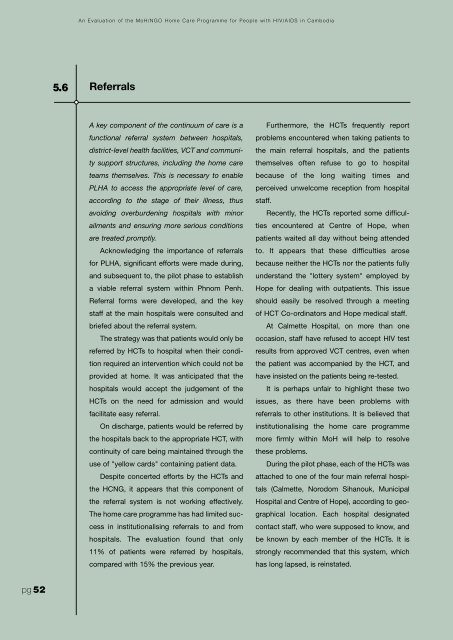PDF File - hivpolicy.org
PDF File - hivpolicy.org
PDF File - hivpolicy.org
- No tags were found...
You also want an ePaper? Increase the reach of your titles
YUMPU automatically turns print PDFs into web optimized ePapers that Google loves.
An Evaluation of the MoH/NGO Home Care Programme for People with HIV/AIDS in Cambodia5.6 ReferralsA key component of the continuum of care is afunctional referral system between hospitals,district-level health facilities, VCT and communitysupport structures, including the home careteams themselves. This is necessary to enablePLHA to access the appropriate level of care,according to the stage of their illness, thusavoiding overburdening hospitals with minorailments and ensuring more serious conditionsare treated promptly.Acknowledging the importance of referralsfor PLHA, significant efforts were made during,and subsequent to, the pilot phase to establisha viable referral system within Phnom Penh.Referral forms were developed, and the keystaff at the main hospitals were consulted andbriefed about the referral system.The strategy was that patients would only bereferred by HCTs to hospital when their conditionrequired an intervention which could not beprovided at home. It was anticipated that thehospitals would accept the judgement of theHCTs on the need for admission and wouldfacilitate easy referral.On discharge, patients would be referred bythe hospitals back to the appropriate HCT, withcontinuity of care being maintained through theuse of "yellow cards" containing patient data.Despite concerted efforts by the HCTs andthe HCNG, it appears that this component ofthe referral system is not working effectively.The home care programme has had limited successin institutionalising referrals to and fromhospitals. The evaluation found that only11% of patients were referred by hospitals,compared with 15% the previous year.Furthermore, the HCTs frequently reportproblems encountered when taking patients tothe main referral hospitals, and the patientsthemselves often refuse to go to hospitalbecause of the long waiting times andperceived unwelcome reception from hospitalstaff.Recently, the HCTs reported some difficultiesencountered at Centre of Hope, whenpatients waited all day without being attendedto. It appears that these difficulties arosebecause neither the HCTs nor the patients fullyunderstand the "lottery system" employed byHope for dealing with outpatients. This issueshould easily be resolved through a meetingof HCT Co-ordinators and Hope medical staff.At Calmette Hospital, on more than oneoccasion, staff have refused to accept HIV testresults from approved VCT centres, even whenthe patient was accompanied by the HCT, andhave insisted on the patients being re-tested.It is perhaps unfair to highlight these twoissues, as there have been problems withreferrals to other institutions. It is believed thatinstitutionalising the home care programmemore firmly within MoH will help to resolvethese problems.During the pilot phase, each of the HCTs wasattached to one of the four main referral hospitals(Calmette, Norodom Sihanouk, MunicipalHospital and Centre of Hope), according to geographicallocation. Each hospital designatedcontact staff, who were supposed to know, andbe known by each member of the HCTs. It isstrongly recommended that this system, whichhas long lapsed, is reinstated.pg 52
















